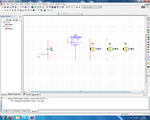pekry416
Newbie level 3
Hi Guys,
I understand that if you connect led's in parallel, the voltage will be the same across all 3 leds?
In multisim I've connected 3 led's in parallel, using LT1761ES5-3 as the regulator to step the voltage down to 3v, and it works perfectly for one led, the voltage is 3v, and when I alternate the circuit Vin between 6 and 13v the voltage to the led remains at 3v, perfect!
However when i add the 2nd led the voltage drops to 2.8v, and then when i add the 3rd led the voltage drops to 2v. Also with these aditional led's when i alternate the circuit Vin the voltage across the leds is also alternating.
Iv attatched a print screen of my circuit. Please could somebody shed some light on the situation as to why the voltage is dropping as im really confused?
Many thanks.

I understand that if you connect led's in parallel, the voltage will be the same across all 3 leds?
In multisim I've connected 3 led's in parallel, using LT1761ES5-3 as the regulator to step the voltage down to 3v, and it works perfectly for one led, the voltage is 3v, and when I alternate the circuit Vin between 6 and 13v the voltage to the led remains at 3v, perfect!
However when i add the 2nd led the voltage drops to 2.8v, and then when i add the 3rd led the voltage drops to 2v. Also with these aditional led's when i alternate the circuit Vin the voltage across the leds is also alternating.
Iv attatched a print screen of my circuit. Please could somebody shed some light on the situation as to why the voltage is dropping as im really confused?
Many thanks.
